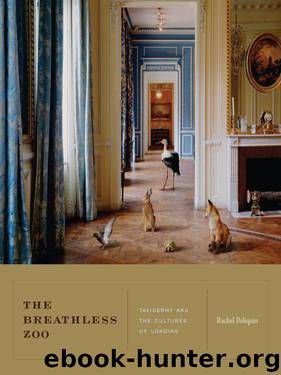The Breathless Zoo: Taxidermy and the Cultures of Longing (Animalibus: Of Animals and Cultures) by Poliquin Rachel

Author:Poliquin, Rachel [Poliquin, Rachel]
Language: eng
Format: epub
Tags: General Fiction
Publisher: Pennsylvania State Univ Pr (Trd)
Published: 2012-08-01T04:00:00+00:00
ANIMAL ATTRACTION
Because species diversity was created prior to humanity, and because we evolved within it, we have never fathomed its limits.
—EDWARD O. WILSON, Biophilia (1984), 10
For purposes of zoological classification, the visible surface of animals is vital, but not as an end in itself, not for the sheer aesthetic pleasure of a zebra’s black-and-white intrigue. The relative beauty of particular animals is ostensibly irrelevant. Instead, physical characteristics become keys or clues. The patterning of stripes and spots, the size of a beak, the shapes of limbs, an absence of claws or horns or glands—all provide crucial pointers that distinguish the similarity and difference of a creature from other species. From the perspective of classification, the physical appearance of animals is only important as a manifestation of zoological order.
As discussed in chapter 1, the wonders cluttering up the sixteenth- and seventeenth-century cabinets of wonder were seen through in the sense that each strange exotic was appreciated as a token of its mysterious homeland, somewhere over the horizon. The orderly arrangements of creatures in natural history museums are also meant to be seen through—not through to reveries of distant landscapes but to a theoretical system, from the particularity of this animal on display to a general concept of its species and the species’ placement within a classification scheme. Within the pedagogy of display, the creatures are meant to vacillate between visible surface and theory, from material beast to a marker within the evolutionary tree. As if to underscore this fact, museum specimens are typically posed in the most neutral attitudes and positions possible: rows and rows of animals and birds, one after the other, without any suggestion of individuality, personality, or habitat—supposedly just the dispassionate display of nature’s diversity.
But no museum could ever possibly display a representative of every species. The diversity of the natural world is simply too astounding. Even the largest museums must always choose which species to display based on the space available. Selection usually begins with broad categories of creatures and moves into smaller groups of genus and species depending on space and available specimens. A small museum might be forced to display only one or two parrots as representatives of the nearly four hundred species of parrots, or just one species of zebra, seagull, or badger.
And which specimen should be chosen as most “typical” of its species? Displaying multiples of each species—male, female, young, old—is usually impossible for reasons of space. If a species varies greatly between male and female, sometimes both sexes will be displayed if space allows. However, usually a male in the prime of life is considered the typical representative. Species with particularly showy males, like peacocks and pheasants, are almost always represented with a male specimen. Such decisions shrink nature down to a more manageable size, which, although hardly comprehensive, is not necessarily detrimental. As Darwin argued, too many animals can be overwhelming, confusing, and chaotic. As with zebras, few visitors expect to see such a plethora of stripes and sizes. The creation
Download
This site does not store any files on its server. We only index and link to content provided by other sites. Please contact the content providers to delete copyright contents if any and email us, we'll remove relevant links or contents immediately.
Sapiens: A Brief History of Humankind by Yuval Noah Harari(14254)
The Tidewater Tales by John Barth(12609)
Mastermind: How to Think Like Sherlock Holmes by Maria Konnikova(7228)
Do No Harm Stories of Life, Death and Brain Surgery by Henry Marsh(6891)
The Thirst by Nesbo Jo(6829)
Why We Sleep: Unlocking the Power of Sleep and Dreams by Matthew Walker(6618)
Life 3.0: Being Human in the Age of Artificial Intelligence by Tegmark Max(5475)
Sapiens by Yuval Noah Harari(5294)
The Longevity Diet by Valter Longo(5021)
The Body: A Guide for Occupants by Bill Bryson(4975)
The Rules Do Not Apply by Ariel Levy(4863)
The Immortal Life of Henrietta Lacks by Rebecca Skloot(4526)
Animal Frequency by Melissa Alvarez(4395)
Why We Sleep by Matthew Walker(4361)
The Hacking of the American Mind by Robert H. Lustig(4319)
Yoga Anatomy by Kaminoff Leslie(4306)
All Creatures Great and Small by James Herriot(4233)
Double Down (Diary of a Wimpy Kid Book 11) by Jeff Kinney(4208)
Barron's AP Biology by Goldberg M.S. Deborah T(4100)
